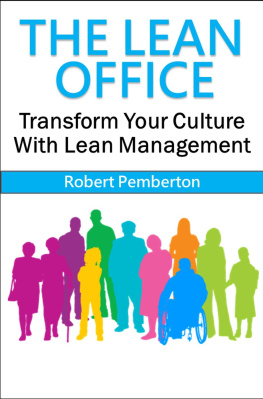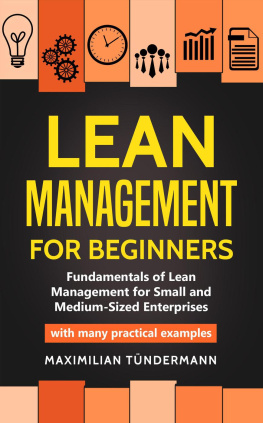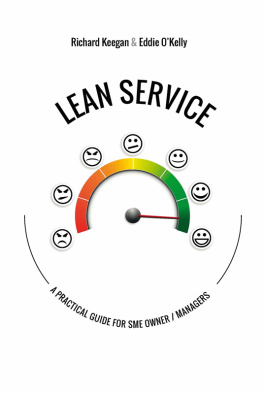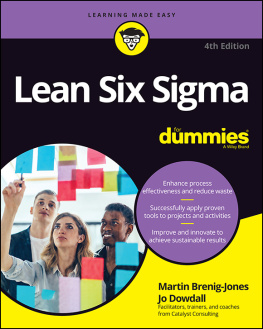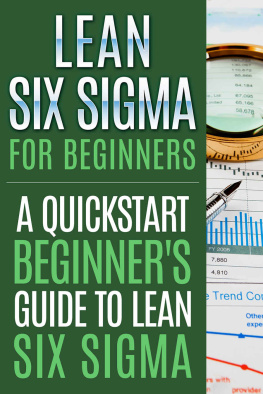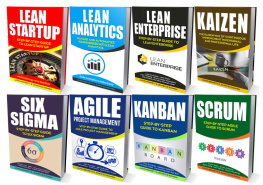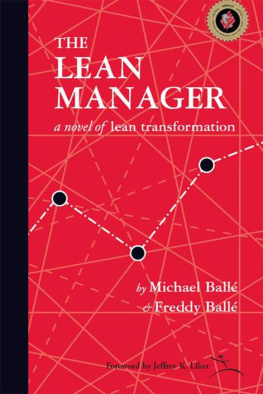Robert Pemberton - The Lean Office: Transform Your Culture with Lean Management
Here you can read online Robert Pemberton - The Lean Office: Transform Your Culture with Lean Management full text of the book (entire story) in english for free. Download pdf and epub, get meaning, cover and reviews about this ebook. year: 2017, publisher: Robert Pemberton, genre: Business. Description of the work, (preface) as well as reviews are available. Best literature library LitArk.com created for fans of good reading and offers a wide selection of genres:
Romance novel
Science fiction
Adventure
Detective
Science
History
Home and family
Prose
Art
Politics
Computer
Non-fiction
Religion
Business
Children
Humor
Choose a favorite category and find really read worthwhile books. Enjoy immersion in the world of imagination, feel the emotions of the characters or learn something new for yourself, make an fascinating discovery.
- Book:The Lean Office: Transform Your Culture with Lean Management
- Author:
- Publisher:Robert Pemberton
- Genre:
- Year:2017
- Rating:4 / 5
- Favourites:Add to favourites
- Your mark:
The Lean Office: Transform Your Culture with Lean Management: summary, description and annotation
We offer to read an annotation, description, summary or preface (depends on what the author of the book "The Lean Office: Transform Your Culture with Lean Management" wrote himself). If you haven't found the necessary information about the book — write in the comments, we will try to find it.
The Lean Office
This book will enable you to transform your culture and enhance your bottom line by implementing Lean Management concepts. Its applicable to all types of offices, large and small. From Fortune 500 companies, thru to Government agencies and to small businesses, by implementing the key principles described in this book, you will improve your triple bottom line of lowering costs, improved production and improved safety.
What is Lean?
A lean culture empowers your employees, removes unnecessary waste, and focuses on the customer. Lean is a way of delivering what your customer needs or wants at the lowest cost and in a timely and efficient manner. Lean is not something that sits apart on a shelf, away from your other business processes and is only used when needed. In contrast, it is your organizations way of life. It should be embedded across all of your processes. Its a way of looking at your business processes through an improvement lens and eliminating waste to ensure the customer is getting the most value. This ensures the customer gets what they ask for, when they need it, at the lowest cost. Lean is focused on delivering customer expectations.
Lean can be applied to virtually every known process whether it be manufacturing, safety, health care or even personal development and personal relationships.
Contents:
The Lean Office.
What is Lean?.
Why Lean?.
Customers.
Value.
Eliminating Waste.
The Lean Office.
Implementing Lean through Values.
The War Room (Lean Boards and Lean Meetings).
The Art of Kaizen (PDCA).
The Kaizen Blitz.
Elimination of Waste (Muda).
Lean Checklists.
5S.
Human Factors (Poka-Yoke).
The 5 Gemba Principles.
The 5 Whys Technique.
Quality Circles (Action Meetings).
Ishikawa diagrams.
Idea Generation.
A3 Problem-solving.
Lean Boards.
Pareto Charts.
Histograms.
Benchmarking.
Robert Pemberton: author's other books
Who wrote The Lean Office: Transform Your Culture with Lean Management? Find out the surname, the name of the author of the book and a list of all author's works by series.

